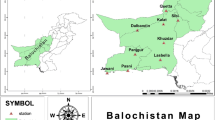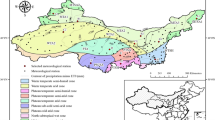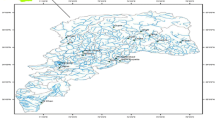Abstract
Drought assessment, characterisation and monitoring increasingly requires considering not only precipitation but also the other meteorological parameters such as an evapotranspiration. Thus, some new drought indices based on precipitation and evapotranspiration have been developed. This study introduces a new drought index named the water surplus variability index (WSVI). The procedure to estimate the index involves accumulation water surplus at different time scales. To approve the proposed procedure, the WSVI is compared with the standardized precipitation index (SPI), the reconnaissance drought index (RDI) and the standardized precipitation evapotranspiration index (SPEI) based on 1-, 3-, 6- and 12-month timescales using data from several weather stations located in regions with different aridity index. Near perfect agreement (d ~ 1) between WSVI and SPI, RDI and SPEI was indicated in humid and sub-humid locations. The results also showed that the correlation coefficients between WSVI and SPI, RDI and SPEI were higher for semi-arid stations than for arid ones.




Similar content being viewed by others
References
Akinremi OO, McGinn SM, Barr AG (1996) Evaluation of the Palmer drought index on the Canadian prairies. J Clim 9:897–905
Allen RG, Pereira LS, Raes D, Smith M (1998) Crop evapotranspiration. guidelines for computing crop water requirements. FAO Irrigation and Drainage Paper 56, Roma
Angelidis P, Maris F, Kotsovinos N, Hrissanthou V (2012) Computation of Drought index SPI with alternative distribution functions. Water Resour Manag 26:2453–2473
Banimahd SA, Khalili D (2013) Factors influencing markov chains predictability characteristics, utilizing SPI, RDI, EDI and SPEI Drought indices in different climatic zones. Water Resour Manag 27:3911–3928
Blenkinsop S, Fowler HJ (2007) Changes in drought characteristics for Europe projected by the PRUDENCE regional climate models. Int J Climatol 27:1595–1610
Dai A, Trenberth KE, Qian T (2004) A global dataset of Palmer Drought severity index for 1870–2002: relationship with soil moisture and effects of surface warming. J Hydrometeorol 5:1117–1130
Gocic M, Trajkovic S (2010) Software for estimating reference evapotranspiration using limited weather data. Comput Electron Agric 71:158–162
Gocic M, Trajkovic S (2013) Analysis of changes in meteorological variables using Mann–Kendall and Sen’s slope estimator statistical tests in Serbia. Glob Planet Chang 100:172–182
Gocic M, Trajkovic S (2014a) Spatiotemporal characteristics of drought in Serbia. J Hydrol 510:110–123
Gocic M, Trajkovic S (2014b) Water surplus variability index as an indicator of drought. J Hydrol Eng. doi:10.1061/(ASCE)HE.1943-5584.0001008
Guttman NB (1998) Comparing the Palmer Drought index and the standardized precipitation index. J Am Water Resour As 34:113–121
Guttman NB (1999) Accepting the standardized precipitation index: a calculation algorithm. J Am Water Resour As 35:311–322
Hosking JRM (1990) L-Moments: analysis and estimation of distributions using linear combinations of order statistics. J Roy Stat Soc 52:105–124
Khalili D, Farnoud T, Jamshidi H, Kamgar-Haghighi AA, Zand-Parsa S (2011) Comparability analyses of the SPI and RDI meteorological drought indices in different climatic zones. Water Resour Manag 25:1737–1757
Li YP, Ye W, Wang M, Yan X (2009) Climate change and drought: a risk assessment of crop-yield impacts. Clim Res 39:31–46
Loukas A, Vasiliades L, Tzabiras J (2008) Climate change effects on drought severity. Adv Geosci 17:23–29
McKee TB, Doesken NJ, Kleist J (1995) Drought monitoring with multiple time scales. In: 9th Conference on applied climatology, American Meteorological Society, Boston, 233–236
Mishra AK, Singh VP (2010) A review of drought concepts. J Hydrol 391:202–216
Narasimhan B, Srinivasan R (2005) Development and evaluation of soil moisture deficit index (SMDI) and evapotranspiration deficit index (ETDI) for agricultural drought monitoring. Agric For Meteorol 133:69–88
Palmer WC (1965) Meteorological Drought, Research paper No. 45, US Department of Commerce Weather Bureau, Washington, DC
Palmer WC (1968) Keeping track of crop moisture conditions, nationwide: the new crop moisture index. Weatherwise 21:156–161
Paulo AA, Rosa RD, Pereira LS (2012) Climate trends and behaviour of drought indices based on precipitation and evapotranspiration in Portugal. Nat Hazards Earth Syst Sci 12:1481–1491
Pereira LS, Rosa RD, Paulo AA (2007) Testing a modification of the Palmer Drought severity index for mediterranean environments. In: Rossi G, Vega T, Bonaccorso B (eds) Methods and tools for Drought analysis and management. Springer, Dordrecht, pp 149–167
Raziei T, Bordi I, Pereira LS (2013) Regional drought modes in Iran using the SPI: the effect of time scale and spatial resolution. Water Resour Manag 27:1661–1674
Sienz F, Bothe O, Fraedrich K (2011) Monitoring and quantifying future climate projections of dryness and wetness extremes: SPI bias. Hydrol Earth Syst Sci Discuss 8:10635–10677
Tabari H, Abghari H, Hosseinzadeh Talaee P (2012) Temporal trends and spatial characteristics of drought and rainfall in arid and semiarid regions of Iran. Hydrol Process 26:3351–3361
Thornthwaite CW (1948) An approach toward a rational classification of climate. Geogr Rev 38:55–94
Trajkovic S (2010) Testing hourly reference evapotranspiration approaches using lysimeter measurements in a semiarid climate. Hydrol Res 41:38–49
Tsakiris G, Pangalou D, Vangelis H (2007) Regional drought assessment based on the Reconnaissance Drought Index (RDI). Water Resour Manag 21:821–833
Tsakiris G, Nalbantis I, Vangelis H, Verbeiren B, Huysmans M, Tychon B, Jacquemin I, Canters F, Vanderhaegen S, Engelen G, Poelmans L, De Becker P, Batelaan O (2013) A system-based paradigm of drought analysis for operational management. Water Resour Manag 27:5281–5297
UNESCO (1979) Map of the world distribution of arid regions: explanatory note. MAP Technical Notes 7, UNESCO: Paris, 54
Vangelis H, Spiliotis M, Tsakiris G (2010) Drought severity assessment based on bivariate probability analysis. Water Resour Manag 25:357–371
Vicente-Serrano SM, Beguería S, López-Moreno JI (2010) A multi-scalar drought index sensitive to global warming: the standardized precipitation evapotranspiration index—SPEI. J Clim 23:1696–1718
Weber L, Nkemdirim LC (1998) The Palmer drought severity index revisited. Geogr Ann A 80:153–172
Wells N, Goddard S, Hayes MJ (2004) A self-calibrating Palmer drought severity index. J Clim 17:2335–2351
Acknowledgments
The study is supported by the Ministry of Education, Science and Technological Development, Republic of Serbia (Grant No. TR37003). The authors wish to express gratitude to Hossein Tabari for access to the weather station data. We thank two anonymous referees for valuable comments and constructive suggestions that helped improve the final version of the article.
Author information
Authors and Affiliations
Corresponding author
Rights and permissions
About this article
Cite this article
Gocic, M., Trajkovic, S. Drought Characterisation Based on Water Surplus Variability Index. Water Resour Manage 28, 3179–3191 (2014). https://doi.org/10.1007/s11269-014-0665-4
Received:
Accepted:
Published:
Issue Date:
DOI: https://doi.org/10.1007/s11269-014-0665-4




